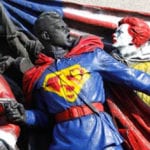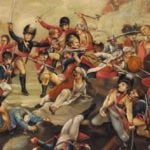 Weird Stuff
Weird Stuff  Weird Stuff
Weird Stuff  Mysteries
Mysteries 10 Tragic Disappearances and Deaths in Joshua Tree National Park
 History
History 10 Ways Childhood Really Sucked in the Old West
 Music
Music 10 Name Origins of Famous Bands from the 1990s
 Religion
Religion 10 Biggest Turnarounds by the Catholic Church
 Weird Stuff
Weird Stuff 10 Unbelievable Times Laws Had Unintended Consequences
 Humans
Humans Ten Historic Women Who Deserve Way More Credit Than They Got
 Movies and TV
Movies and TV 10 Films That Spawned Major Lawsuits
 History
History Ten Times Towns Were Wiped Off the Face of the Earth
 Creepy
Creepy 10 of the Most Disturbingly Haunted Public Houses in the UK
 Weird Stuff
Weird Stuff 10 Niche Subcultures That Are More Popular Than You Might Think
 Mysteries
Mysteries 10 Tragic Disappearances and Deaths in Joshua Tree National Park
 History
History 10 Ways Childhood Really Sucked in the Old West
Who's Behind Listverse?

Jamie Frater
Head Editor
Jamie founded Listverse due to an insatiable desire to share fascinating, obscure, and bizarre facts. He has been a guest speaker on numerous national radio and television stations and is a five time published author.
More About Us Music
Music 10 Name Origins of Famous Bands from the 1990s
 Religion
Religion 10 Biggest Turnarounds by the Catholic Church
 Weird Stuff
Weird Stuff 10 Unbelievable Times Laws Had Unintended Consequences
 Humans
Humans Ten Historic Women Who Deserve Way More Credit Than They Got
 Movies and TV
Movies and TV 10 Films That Spawned Major Lawsuits
 History
History Ten Times Towns Were Wiped Off the Face of the Earth
 Creepy
Creepy 10 of the Most Disturbingly Haunted Public Houses in the UK
10 Inside Jobs That Governments Blamed On Enemies
In a false flag operation, the government or another group stages an event to look like it was carried out by someone besides the real perpetrators. The deceivers use this tactic to discredit another group and start wars, enact severe laws, overthrow political opponents, gain alliances, or otherwise get an advantage. As we will see, those carrying out the acts are all too willing to sacrifice lives or promote fear and violence to solidify their ruses. Some of these events are proven to be false flags, while others are simply suspected.
10The Sinking Of The USS Maine

In 1898, Cuba was embroiled in its war for independence from Spain, and the US sent its Navy ship USS Maine down to Havana to protect supposed US interests. Three weeks after arriving, the Maine exploded, killing 260 men. Although there was no proof, sensationalist headlines convinced Americans that Spain was responsible, and the people demanded war, with their rallying cry “Remember the Maine, to Hell with Spain.”
Thus began the short-lived Spanish-American War. In a little over three months, the war was finished. The US, being the victor, seized many of Spain’s colonies, including Cuba, Puerto Rico, and the Philippines. All in all, things worked out pretty well for the Americans, and Secretary of State John Hay even referred to it as a “splendid little war.”
Still, not everyone agrees that things happened as straightforwardly or as splendidly as they appeared. Some say that the US was actually responsible for destroying the USS Maine as a ploy to incite war, oust Spain from Cuba, and take control of Spanish holdings. US officials have never admitted to this, but Cuba is convinced that the sinking was a false flag event. A USS Maine monument in Cuba even describes the ship’s sailors as “victims sacrificed to the imperialist greed in its fervor to seize control of Cuba.” Of course, the monument could simply be an example or Cold War propaganda, so we can’t exactly take Cuba’s word for it, and all other investigations into the Maine have come up inconclusive.
While that would have been the end of the story, suspicions about US involvement in the Maine explosion resurfaced in the 1990s when documents about Operation Northwoods and Operation Mongoose became public (both were false flag events planned by the US government). In particular, there was mention in the Operation Mongoose papers about employing a “Remember the Maine incident” against the Castro regime by blowing up a US ship in Guantanamo Bay and blaming the Cubans. So, when the papers referred to the “Maine incident,” the question remains: Were government officials talking about recreating an event that happened naturally, or were they referencing a previous, successful act of deception?
9Operation Himmler

By 1939, Hitler was chomping at the bit for war and had systematically subjected the German people to anti-Polish propaganda. Still, he needed one great event to solidify the Germans against Poland, creating a pretext for attack. And so he enacted Operation Himmler, which had the goal of making the Polish look like the aggressors against Germany.
The plan was carried out at nightfall on August 31 and is considered the first real act of World War II. It involved dressing SS and SD (Nazi paramilitary and intelligence) men in Polish Army uniforms and having them storm German border towns. The disguised SS troops entered the towns while firing shots, vandalizing buildings, and generally wreaking havoc among their own people. In the city of Gleiwitz, they hijacked a radio station and repeatedly shouted in Polish, “People of Poland, the time has come for war between Poland and Germany!”
To make things more convincing, the Nazis shot and killed concentration camp victims and Polish sympathizers (referring to them as “canned goods” throughout the operation), dressed them in Polish uniforms, and left them at the scenes of the skirmishes. The press photographed them and showed the world that the Poles were the invaders.
Having set the stage to justify war, Germany attacked Poland the following day, and World War II officially began. Operation Himmler was proven a false flag maneuver during the Nuremberg Trials.
8Operation Ajax

Operation Ajax was a 1953 plan hatched by British and US intelligence to overthrow democratically elected Iranian leader Mohammed Mossadegh and return the pro-US Shah to power. Britain, worried about Iran’s plans to nationalize its oil industry, came up with the idea and later convinced the US of the joint operation.
Although we’ve previously discussed how the British SIS and American CIA used various forms of bribery to sway Iranian politics in their favor, we didn’t mention the multiple, often violent false flag incidents that were carried out to undermine Mossadegh and his followers. For instance, in one case, Iranians working for the CIA posed as communist Mossadegh-supporters. They staged a bombing at a cleric’s home to anger the Muslim community and pit them against Mossadegh’s government. They also threatened other religious leaders with brutal punishment if they failed to endorse Mossadegh. Furthermore, the CIA incited riots, set fire to buildings, and bolstered protesters—all while pretending to be Iranian citizens. The resulting violence initiated by the US and the British killed 300–800 people.
In the end, Operation Ajax was successful. The Shah was put back in power, and Britain regained its control over the Anglo-Iranian Oil Company (now known as British Petroleum or BP). The details of the operation, including the false flags, are detailed in documents released by the Freedom of Information Act.
7The Soviet Union Bombed Russia

After seeing the success of Operation Himmler, the USSR took a page out of Hitler’s playbook and staged its own casus belli for going to war with a neighboring country. Similar to how the Germans assaulted themselves and blamed it on Poland, on November 26, 1939, the Soviets shelled the Russian village of Mainila and claimed that Finland was the perpetrator.
Finland denied responsibility, arguing that their artillery was out of range to even reach Mainila. They suggested a neutral investigation to settle the matter. But the Soviets had no interest in negotiations and swiftly renounced the Soviet-Finland Non-Aggression Pact. Four days later, they invaded Finland, and the deadly Winter War began.
Prior to the war, Stalin had tried to reach a deal with the Finns where the USSR would annex part of their country to protect the nearby Soviet city of Leningrad. The USSR was worried about a German attack through Finland and wanted to gain an offensive foothold in the region. Apparently, when the Finnish turned down the proposition, the Soviets figured they would just take what they wanted.
The shelling of Mainila killed four Russian soldiers and wounded nine others. However, considering Stalin’s Great Purge (where he killed up to one million of his own people), it should come as no surprise that the leader was willing to sacrifice a few innocents for a cause. Still, the shelling led to many more deaths, as there were around 125,000 Soviet causalities and 25,000 Finnish losses in the Winter War.
Today, there’s no real question that the USSR raided itself and accused the Finns. The fact has been documented by many historians, and Nikita Khrushchev admitted that the Winter War was an act of Soviet aggression.
6The Reichstag Fire

On the night of February 27, 1933, an arsonist burned down the German parliament (Reichstag) building. Dutchman Marinus van der Lubbe said he was responsible for starting the fire, saying that he was a communist who wanted to take revenge on capitalism.
Among the first at the scene was Hermann Goering (yes, that Goering), who was the Prussian interior minister at the time. He immediately announced the government’s plans to quell a communist uprising, and he conveniently already had a list of communists due for arresting. His quick response and eagerness to blame the entire communist party for the happening leads some to believe that Goering orchestrated the fire as a false flag against the communists. In fact, during the Nuremberg Trials, he was questioned about an incident where German General Franz Halder supposedly overheard Goering admitting to his role in the Reichstag fire. Goering denied any such admission.
Although there’s still some debate on who was truly responsible, it’s undeniable that the coalition government (Nazis and the German Nationalist People’s Party) used the situation to their advantage. After the fire, using the supposed communist uprising as justification, the government enacted an emergency decree, which “suspended the right to assembly, freedom of speech, freedom of the press, and other constitutional protections, including all restraints on police investigations.” The emergency powers were far from temporary, as they ultimately led to the dictatorial rights that gave further rise to the Nazi party and Hitler.
5Mukden Incident Of 1931

During the early 20th century, Japan held special rights over a southern area of Manchuria in China. They operated it as a supposedly neutral territory, using it to defend their colony in Korea and protect their investments in the South Manchuria Railway Company.
However, as China became more unified under the Nationalist leader Chiang Kai-shek, the Japanese started to worry about losing their stronghold in Manchuria. They also feared Soviet invasion from the north—especially since Japan had taken southern Manchuria from the Russians during the 1904–1905 Russo-Japanese War. Those facts, combined with their then-desire for expansion, made some Japanese leaders think invading China was a necessary step. But first, they had to make China look like the aggressors.
Their plan, which is now known as the Mukden or Manchurian Incident, involved the self-sabotage of a Japanese-owned railway. In 1931, Japanese Colonel Seishiro Itagaki and Liuetenant Colonel Kanji Ishiwara orchestrated the bombing of a section of rail tracks in Mukden and then blamed the incident on the Chinese. This was used as a pretext to invade the inner Manchurian town of Shenyang.
The Chinese denied any involvement and ordered Japan to withdraw its troops from Shenyang. Although the Japanese government agreed to China’s demands, the Japanese army had other ideas. Instead of withdrawing, they launched a full-scale invasion of Manchuria, seizing power and making it a puppet state. The Manchurian people suffered horrific atrocities under Japanese rule, including being part of the human experiments in the notorious Unit 731 facility.
While it’s generally agreed that the Japanese were behind the railroad bombings, there’s still some debate over whether the official government approved of the event or if it was solely the brainchild of military hotheads.
4Macedonian Police Frame Terrorists

Since becoming independent from Yugoslavia in 1991, Macedonians have eagerly tried to gain favor with Western allies. They joined the War on Terror, have been an ally to the US, and even sent troops into Iraq.
However, in 2002, in a disturbing act of overzealousness to impress, a group of Macedonian police officers intentionally gunned down seven illegal immigrants, calling them Pakistani militants intent on attacking foreign embassies. The men were not terrorists. They’d been lured into Macedonia by the police with the promise they would be given safe passage to Western Europe. Instead, they were shot in cold blood, their bodies left lying beside machine guns to make it seem like they’d been firing at the police.
People were immediately suspicious that the gunfight was staged. For instance, no one could explain why all seven of the heavily armed supposed terrorists died but the police were injury-free. Also, the police officers’ stories were inconsistent and changed during interrogations.
In the end, Macedonian officials admitted that the immigrants had been murdered to impress the international community. Five police officers, a businessman, and interior minister Ljube Boskovski were charged with the crime.
3The FBI Creates Terrorist Plots

The Macedonians aren’t the only ones deceptively trying to make it look as though they’re thwarting terror attacks. America’s FBI has staged quite a few similar events, only their plans are a bit more sophisticated and typically don’t involve direct bloodshed. They do, however, involve a combination of false flag strategies along with what seems to be entrapment.
The FBI has repeatedly encouraged and sometimes paid Muslims to commit terrorist acts. Right before the would-be terrorists can carry out the assault, the FBI swoops in and claims to save the day. The FBI never informs the public that it concocted the plan. It simply takes credit for keeping the public safe. This effectively raises a false flag on the American people and keeps the citizens fearful of terror groups while erroneously reinforcing the notion that the FBI is capturing terrorists.
In one case, the FBI provided an Oregon college student with a van loaded with fake but realistic-looking explosives. They drove the student to a crowded public event, encouraged him to set off the dummy bomb, and then arrested him after he tried to trigger the detonation code. In similar setups, the FBI has orchestrated and then thwarted terrorist plans to shoot down aircraft, take explosives on planes, and become suicide bombers.
US Attorney General Eric Holder says these FBI operations are not entrapment and are “essential in fighting terrorism.” On the other hand, Human Rights Watch argues that the FBI targets those with mental problems, of low intelligence, or who are otherwise vulnerable. The FBI is creating terrorists out of people who wouldn’t have committed a crime without the FBI’s encouragement.
2Italian Police Fake Evidence

The 2001 G8 summit drew around 200,000 protesters who called it an unlawful attempt by powerful governments to establish rules for the entire world. Italian police and politicians became frustrated with the protesters, who, in their opinion, were trying to block the rightful workings of governments and create mayhem. They also feared that such a large demonstration could create a breeding ground for terrorism and other violence.
Tensions were high between law enforcement and protesters, and the police officers became increasingly aggressive throughout the event. Wanting to put an end to the debacle, a group of officers conducted a night raid on a dormitory building where many of the demonstrators were staying. But they couldn’t conduct a raid without provocation, so they planted Molotov cocktails in the dormitory and faked the stabbing of an officer, giving the illusion that the protesters were violent and in need of an equally violent crackdown.
The police took the building by storm and beat the protesters so badly that the dorms were described as looking like a “Mexican slaughterhouse” spattered with blood. Police arrested 93 people, with 72 of them suffering injuries. All of them were later released without charge.
Despite the government’s continued defense of the officers, the courts determined that some of Italy’s most senior police were guilty of framing and attacking the protesters. It was also shown that the assault was planned and covered up at the highest levels.
1Turkey Bombs Its Own Consulate

Tensions between the Greeks and Turks date back to the 1450s, when the Ottoman Empire conquered Constantinople (now Istanbul). After World War I, both groups agreed to a population exchange, where Greeks had to go to Greece, and Turks had to go to Turkey. The only people exempt from the mandate were the Greeks living in Turkey’s Istanbul, since they had religious ties to the city.
This didn’t go over too well. By 1955, many Turks intensely wanted every Greek out of Istanbul, and on August 28, one of the largest daily newspapers in Turkey printed this ominous statement: “If the Greeks dare touch our brethren, then there are plenty of Greeks in Istanbul to retaliate upon.” This article was just one piece of planned propaganda by the Turks meant to sway their people into believing that the Greeks were an imminent threat.
A few days later, bombs were detonated at the Turkish consulate in Thessaloniki, damaging the nearby historic home of Turkey’s beloved founder Kemal Ataturk. The Turks were well primed to blame the assault on their enemies. Turkish mobs responded with force against Greeks living in Istanbul (as well as any Armenians who got in the way), and vicious riots ravaged the city for nine hours.
Most of the mobs were government-organized and were conveniently trucked into the city before the bombing occurred. By the end of the Istanbul Riots, an estimated 38 people were dead, and over 4,000 Greek homes, shops, schools, and cemeteries were destroyed and plundered. In the following days, Istanbul’s Greek population plummeted from around 100,000 to only a few thousand, as they fled their homeland en masse.
Later, when on trial, Turkish Prime Minister Adnan Menderes admitted that the consulate bombings were indeed a false flag operation carried out by government-ordered Turkish agents. He apologized for the act and offered the Greek government monetary compensation for damaged and lost property.
Content and copy writer by day and list writer by night, S. Grant enjoys exploring the bizarre, unusual, and topics that hide in plain sight. Contact S. Grant here.








